A 2.4 GHz 20 W 8-channel RF Source Module with Solid-State Power Amplifiers for Plasma Generators
Abstract
:1. Introduction
2. Design of the Proposed Power Amplifier Module
- Sequence 1
- (Off-state): when 48 V of the main DC bias is applied first, it is converted from 48 V to 5 V through the low dropout regulator (LDO) and supplied to a voltage controlled oscillator (VCO), variable gain amplifier (VGA), drive PA, negative charge pump and so on. In addition, some are converted to negative voltage through a negative charge pump. Because the transistors have to be ensured to be in the off state before applying drain bias, −5 V is applied as the gate bias of the main PA.
- Sequence 2
- (Ideal state #1): VSSR_EN of the solid-state relay (SSR) is turned on to supply 48 V DC bias to the drain of the main PA.
- Sequence 3
- (Ideal state #2): VHPA_EN and VDRV_EN are activated to turn the main PA and drive PA on, respectively.
- Sequence 4
- (Power emission): when VSRC_EN is activated to make the VCO switch to the on state, the proposed module generates 20 W output power at each channel.
3. Measurement Results
4. Conclusions
Author Contributions
Funding
Conflicts of Interest
References
- Wang, Q.; Wu, G.; Liu, S.; Gan, Z.; Yang, B.; Pan, J. Simulation-Based Development of a New Cylindrical-Cavity Microwave-Plasma Reactor for Diamond-Film Synthesis. Crystals 2019, 9, 320. [Google Scholar] [CrossRef] [Green Version]
- Szabó, D.V.; Schlabach, S. Microwave Plasma Synthesis of Materials—From Physics and Chemistry to Nanoparticles: A Materials Scientist’s Viewpoint. Inorganics 2014, 2, 468–507. [Google Scholar] [CrossRef] [Green Version]
- Petreuş, D.; Grama, A.; Cadar, S.; Plaian, E.; Rusu, A. Design of a plasma generator based on E power amplifier and impedance matching. In Proceedings of the 2010 12th International Conference on Optimization of Electrical and Electronic Equipment, Basov, Romania, 20–22 May 2010; pp. 1317–1322. [Google Scholar]
- Miotk, R.; Jasinski, M.; Mizeraczyk, J. Optimization of microwave power transfer from electric field to the plasma inside an microwave 915 MHz plasma source. In Proceedings of the 2016 International Conference on Actual Problems of Electron Devices Engineering (APEDE), Saratov, Russia, 22–23 September 2016; pp. 1–8. [Google Scholar]
- Miotk, R.; Jasinski, M.; Mizeraczyk, J. Improvement of Energy Transfer in a Cavity-Type 915-MHz Microwave Plasma Source. IEEE Trans. Microw. Theory Tech. 2017, 66, 711–716. [Google Scholar] [CrossRef]
- Pengelly, R.S.; Wood, S.M.; Milligan, J.W.; Sheppard, S.T.; Pribble, W.L. A Review of GaN on SiC High Electron-Mobility Power Transistors and MMICs. IEEE Trans. Microw. Theory Tech. 2012, 60, 1764–1783. [Google Scholar] [CrossRef]
- Horikoshi, S.; Serpone, N. (Eds.) RF Power Semiconductor Generator Application in Heating and Energy Utilization; Springer Nature: Singapore, 2020; pp. 25–39, 181–194. [Google Scholar]
- Chen, F.F.; Chang, J.P. Lecture Notes on Principles of Plasma Processing; Springer Science and Business Media: New York, NY, USA, 2003; pp. 25–30. [Google Scholar]
- Wu, R.; Benqing, G.; Zhenghui, X.; Weiming, L. The study of the rf field in a plasma reactor. In Proceedings of the Cross Strait Quad-Regional Radio Science and Wireless Technology Conference (CSQRWC) 2012, New Taipei City, Taiwan, 23–27 July 2012; pp. 191–194. [Google Scholar]
- Pozar, D.M. Microwave Engineering, 4th ed.; Wiley: Hoboken, NJ, USA, 2012; pp. 564–570. [Google Scholar]
- Gonzalez, G. Microwave Transistor Amplifiers: Analysis and Design, 2nd ed.; Prentice Hall: Upper Saddle River, NJ, USA, 1997; pp. 217–227. [Google Scholar]
- Pantoli, L.; Leuzzi, G.; Santarelli, A.; Filicori, F. Stability Analysis and Design Criteria of Paralleled-Device Power Amplifiers Under Large-Signal Regime. IEEE Trans. Microw. Theory Tech. 2016, 64, 1442–1455. [Google Scholar] [CrossRef]
- Pantoli, L.; Leuzzi, G.; Santarelli, A.; Filicori, F.; Giofrè, R. Stabilisation approach for multi-device parallel power amplifiers under large-signal regime. In Proceedings of the 2011 6th European Microwave Integrated Circuit Conference, Manchester, UK, 10–11 October 2011; pp. 144–147. [Google Scholar]
- Bansleben, C.; Heinrich, W. Compact high-power high-efficiency microwave generator with differential outputs. In Proceedings of the 2014 44th European Microwave Conference, Rome, Italy, 6–9 October 2014; pp. 723–726. [Google Scholar]
- Korpas, P.; Gryglewski, D.; Wojtasiak, W.; Gwarek, W. A Computer-controlled System of High-power Microwave Sources. Int. J. Electron. Telecommun. 2011, 57, 121–126. [Google Scholar] [CrossRef]
- Latrasse, L.; Radoiu, M.; Lo, J.; Guillot, P. 2.45-GHz microwave plasma sources using solid-state microwave generators. Collisional-type plasma source. J. Microw. Power Electromagn. Energy 2017, 51, 43–58. [Google Scholar] [CrossRef]
- Latrasse, L.; Radoiu, M.; Lo, J.; Guillot, P. 2.45-GHz microwave plasma sources using solid-state microwave generators. ECR-type plasma source. J. Microw. Power Electromagn. Energy 2017, 50, 308–321. [Google Scholar] [CrossRef]
- Tong, X.C. Advanced Materials for Thermal Management of Electronic Packaging; Springer: Berlin, Germany, 2011; pp. 1–55, 305–370, 421–473. [Google Scholar]
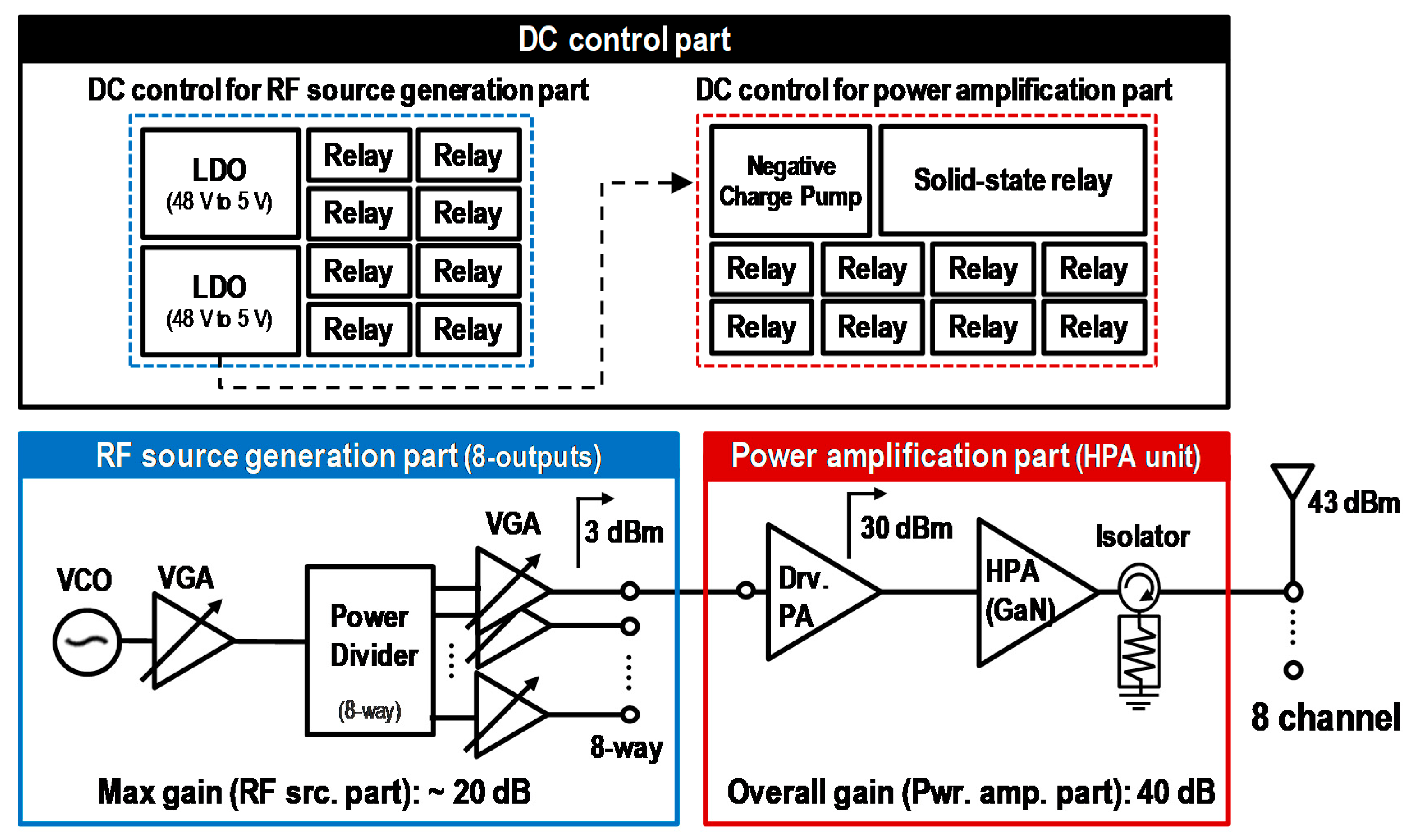
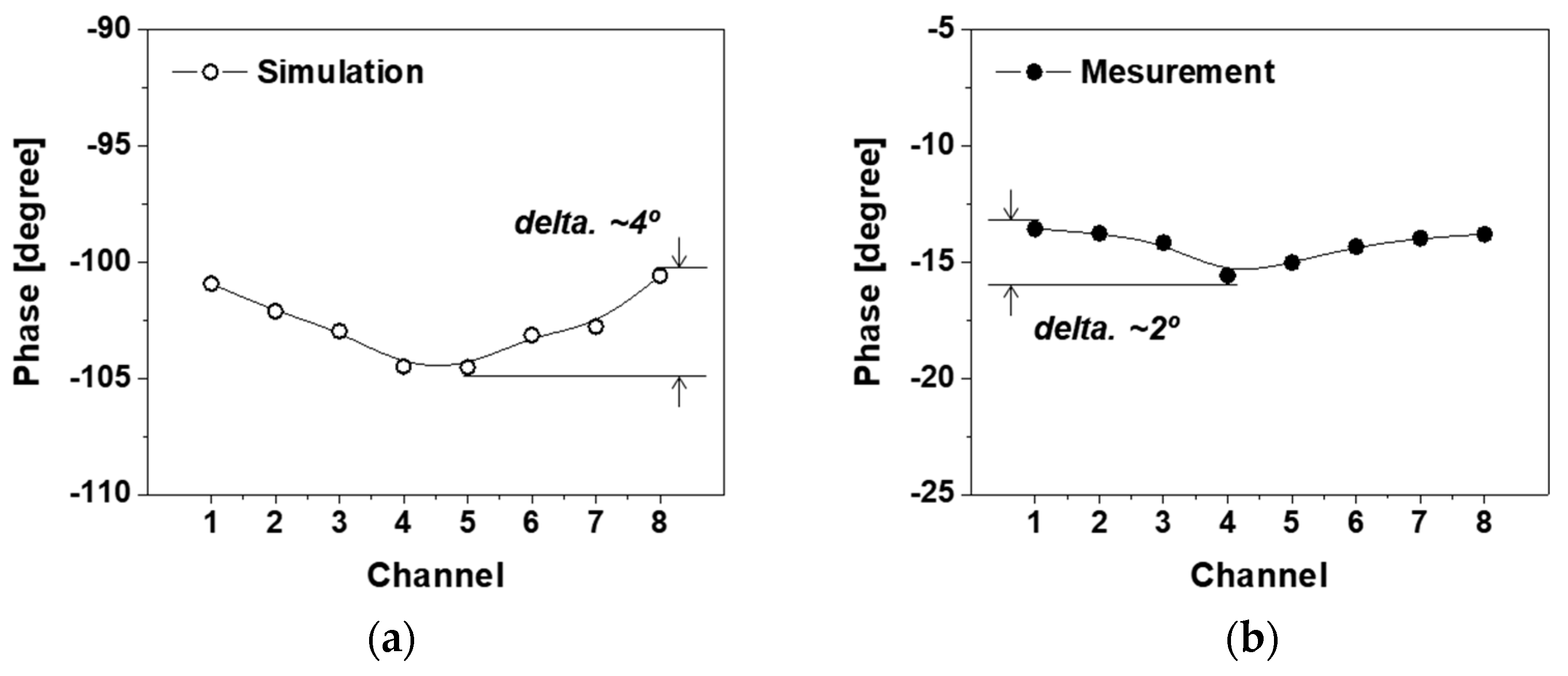
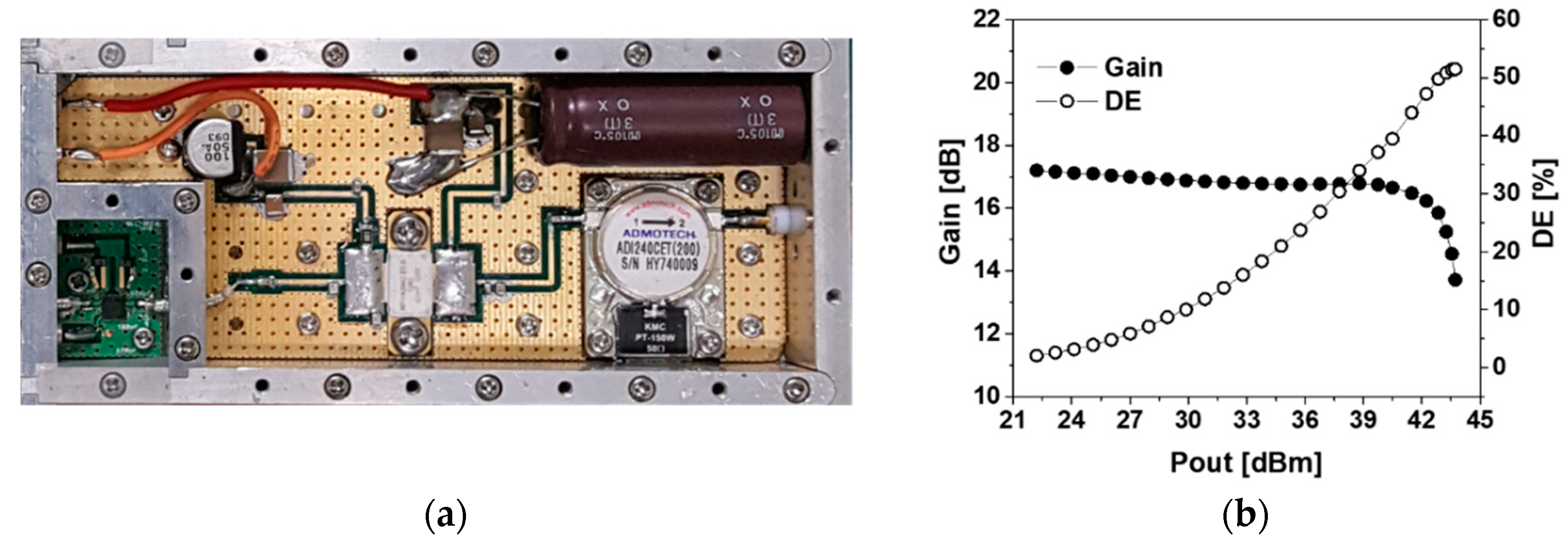

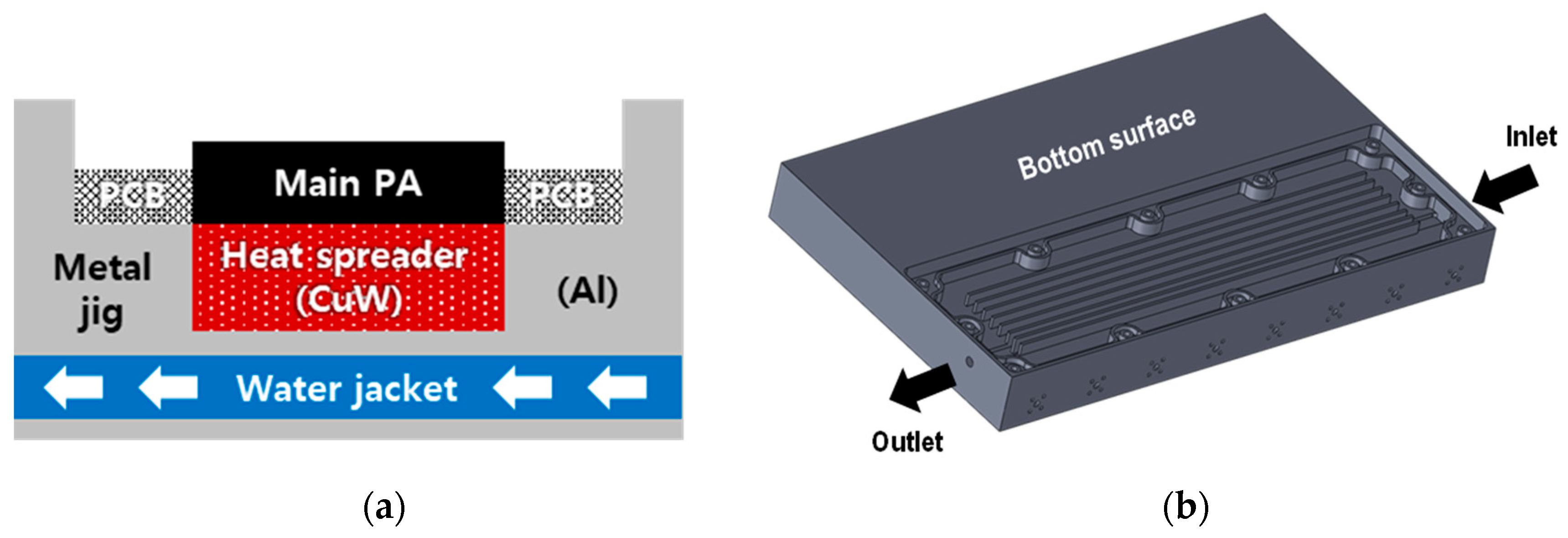
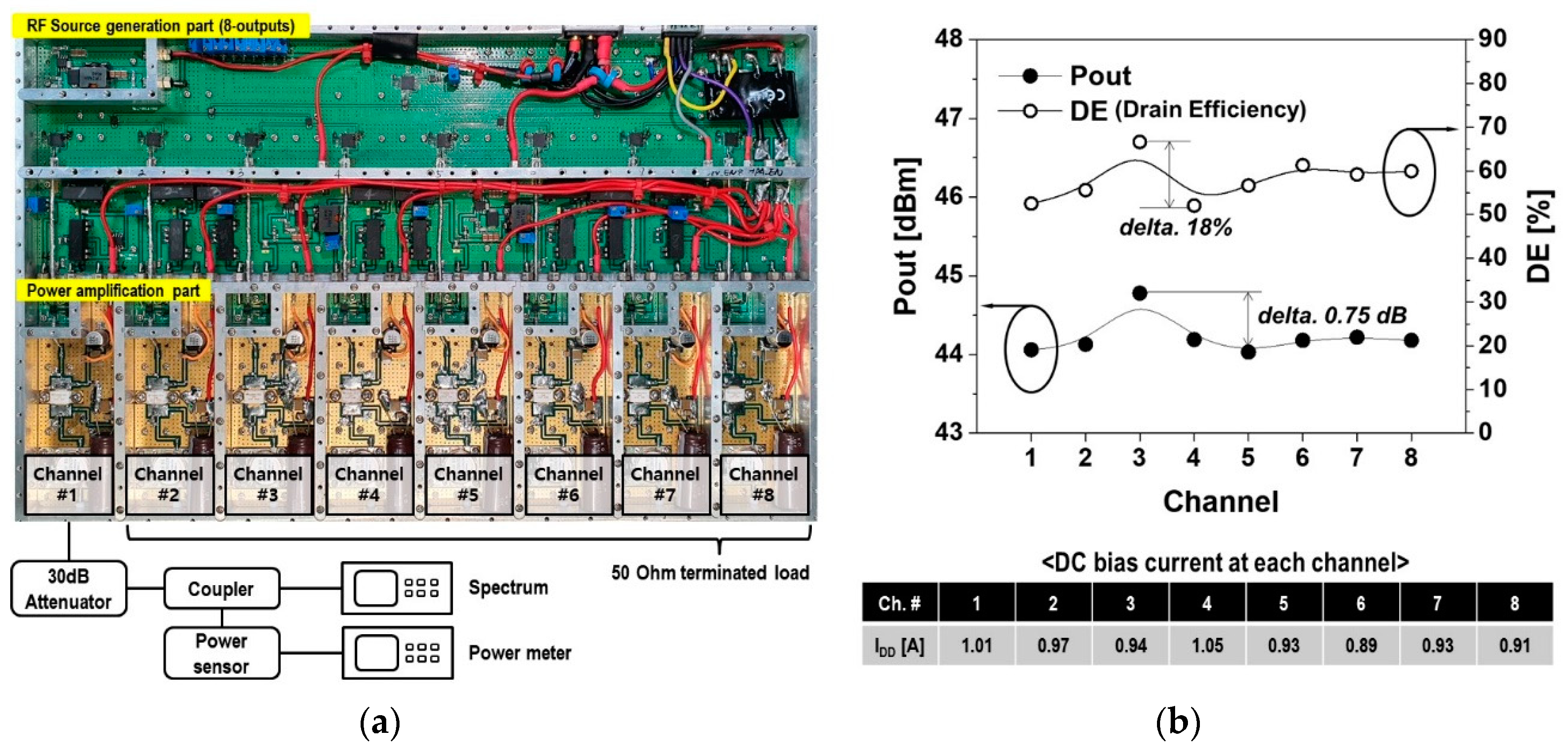
| Control Bias | DC Level | Description |
|---|---|---|
| Vsupply | 48 V, 7.63 A | Main DC source |
| VSSR_EN | high (5 V) or low (0 V) | Control bit for enabling the drain supply bias of main PAs |
| VHPA_EN | Common control bit for main PAs on/off | |
| VDRV_EN | Common control bit for drive PAs on/off | |
| VSRC_EN | Control bit for RF source on/off |
| Sequence | VSRC_EN | VDRV_EN | VHPA_EN | VSSR_EN | Description |
|---|---|---|---|---|---|
| 1 | L | L | L | L | Off-state |
| 2 | L | L | L | H | Ideal state #1 |
| 3 | L | H | H | H | Ideal state #2 |
| 4 | H | H | H | H | Power emission |
| Ref. | Freq. (GHz) | Topology (Device) | Pout (W) | Linear Gain (dB) | Eff. (%) | Output | Cooling System |
|---|---|---|---|---|---|---|---|
| [14] | 2.4 | Differential PA (GaN) | 57 | - | 47 | 1-channel | None |
| [15] | 2.45 | 2-stage PA (GaN) | 200 | 25 | - | 4-channels | None |
| [16] | 2.45 | - | 200 | - | - | 1-channel × N ea | None |
| [17] | 2.45 | - | 200 | - | - | 1-channel × N ea | None |
| This work | 2.4 | 2-stage PA (GaAs, GaN) | 20 (CW) | >40 | >50 | 8-channel | Liquid cooling |
© 2020 by the authors. Licensee MDPI, Basel, Switzerland. This article is an open access article distributed under the terms and conditions of the Creative Commons Attribution (CC BY) license (http://creativecommons.org/licenses/by/4.0/).
Share and Cite
Nam, H.; Sim, T.; Kim, J. A 2.4 GHz 20 W 8-channel RF Source Module with Solid-State Power Amplifiers for Plasma Generators. Electronics 2020, 9, 1378. https://doi.org/10.3390/electronics9091378
Nam H, Sim T, Kim J. A 2.4 GHz 20 W 8-channel RF Source Module with Solid-State Power Amplifiers for Plasma Generators. Electronics. 2020; 9(9):1378. https://doi.org/10.3390/electronics9091378
Chicago/Turabian StyleNam, Hyosung, Taejoo Sim, and Junghyun Kim. 2020. "A 2.4 GHz 20 W 8-channel RF Source Module with Solid-State Power Amplifiers for Plasma Generators" Electronics 9, no. 9: 1378. https://doi.org/10.3390/electronics9091378





